1765 AUSTRIA Maria Theresia Antique Silver 1/2 Thaler Austrian Coin NGC i83709
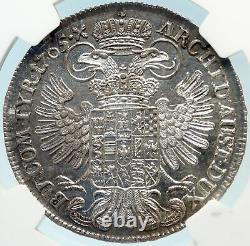
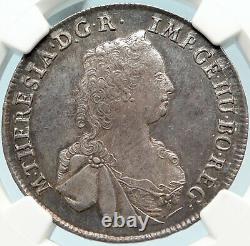
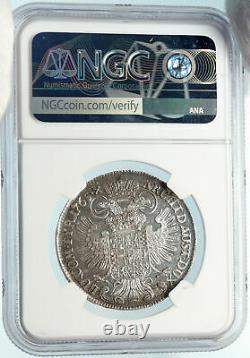
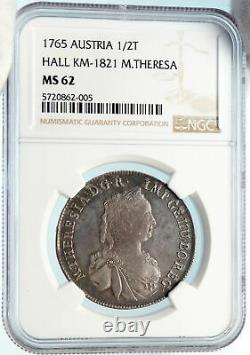
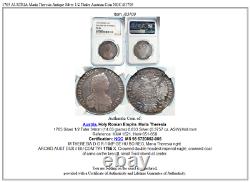

Item: i83709 Authentic Coin of. 1765 Silver 1/2 Taler 34mm (14.03 grams) 0.833 Silver 0.3757 oz.
ASW Hall mint Reference: KM# 1821, Her# 651-658. M THERESIA D G R // IMP GE HU BO REG, Maria Theresia right. ARCHID AUST DUX // BU COM TYR 1765 X, Crowned double headed imperial eagle, crowned coat of arms on the breast, small Tyrol shield at center.The war included peripheral events such as King George's War in British America, the War of Jenkins' Ear (which formally began on 23 October 1739), the First Carnatic War in India, the Jacobite rising of 1745 in Scotland, and the First and Second Silesian Wars. The cause of the war was Maria Theresa' alleged ineligibility to succeed to her father Charles VI's various crowns, because Salic law precluded royal inheritance by a woman.
This was to be the key justification for France and Prussia, joined by Bavaria, to challenge Habsburg power. Maria Theresa was supported by Britain, the Dutch Republic, Sardinia and Saxony. Spain, which had been at war with Britain over colonies and trade since 1739, entered the war on the Continent to re-establish its influence in northern Italy, further reversing Austrian dominance over the Italian peninsula that had been achieved at Spain's expense as a consequence of Spain's war of succession earlier in the 18th century. The war ended with the Treaty of Aix-la-Chapelle in 1748, by which Maria Theresa was confirmed as Archduchess of Austria and Queen of Hungary, but Prussia retained control of Silesia.
Maria Theresa Walburga Amalia Christina (German: Maria Theresia ; 13 May 1717 - 29 November 1780) was the only female ruler of the Habsburg dominions and the last of the House of Habsburg. She was the sovereign of Austria, Hungary, Croatia, Bohemia, Transylvania, Mantua, Milan, Lodomeria and Galicia, the Austrian Netherlands and Parma. By marriage, she was Duchess of Lorraine, Grand Duchess of Tuscany and Holy Roman Empress. She started her 40-year reign when her father, Emperor Charles VI, died in October 1740.Charles VI paved the way for her accession with the Pragmatic Sanction of 1713 and spent his entire reign securing it. Upon the death of her father, Saxony, Prussia, Bavaria, and France all repudiated the sanction they had recognised during his lifetime. Frederick II of Prussia (who became Maria Theresa's greatest enemy for most of her reign) promptly invaded and took the affluent Habsburg province of Silesia in the nine-year conflict known as the War of the Austrian Succession.
Over the course of the war, despite the loss of Silesia and a few minor territories in Italy, Maria Theresa successfully defended her rule over most of the Habsburg empire. Maria Theresa later unsuccessfully tried to reconquer Silesia during the Seven Years' War. Maria Theresa and her husband, Francis I, Holy Roman Emperor, had eleven daughters, including the Queen of France and Navarre, the Queen of Naples and Sicily, the Duchess of Parma, and five sons, including two Holy Roman Emperors, Joseph II and Leopold II.
Of the sixteen children ten survived to adulthood. Though she was expected to cede power to Francis and Joseph, both of whom were officially her co-rulers in Austria and Bohemia, Maria Theresa was the absolute sovereign who ruled with the counsel of her advisers. She criticised and disapproved of many of Joseph's actions. Maria Theresa understood the importance of her public persona and was able to simultaneously evoke both esteem and affection from her subjects.
Maria Theresa promulgated financial and educational reforms, with the assistance of Count Friedrich Wilhelm von Haugwitz and Gerard van Swieten, promoted commerce and the development of agriculture, and reorganised Austria's ramshackle military, all of which strengthened Austria's international standing. However, she refused to allow religious pluralism and advocated for the state church and contemporary adversary travelers criticized her regime as bigoted and superstitious. As a young monarch who fought two dynastic wars, she believed that her cause should be the cause of her subjects, but in her later years she would believe that their cause must be hers. Austria , officially the Republic of Austria (German: Republik Österreich) , is a federal republic and a landlocked country of over 8.5 million people in Central Europe. It is bordered by the Czech Republic and Germany to the north, Hungary and Slovakia to the east, Slovenia and Italy to the south, and Switzerland and Liechtenstein to the west. The territory of Austria covers 83,879 square kilometres (32,386 sq mi). Austria's terrain is highly mountainous, lying within the Alps; only 32% of the country is below 500 metres (1,640 ft), and its highest point is 3,798 metres (12,461 ft).The majority of the population speak local Bavarian dialects of German as their native language, and Austrian German in its standard form is the country's official language. Other local official languages are Hungarian, Burgenland Croatian, and Slovene. The origins of modern-day Austria date back to the time of the Habsburg dynasty when the vast majority of the country was a part of the Holy Roman Empire. From the time of the Reformation, many Northern German princes, resenting the authority of the Emperor, used Protestantism as a flag of rebellion.
The Thirty Years War, the influence of the Kingdom of Sweden and Kingdom of France, the rise of the Kingdom of Prussia, and the Napoleonic invasions all weakened the power of the Emperor in the North of Germany, but in the South, and in non-German areas of the Empire, the Emperor and Catholicism maintained control. During the 17th and 18th centuries, Austria was able to retain its position as one of the great powers of Europe and, in response to the coronation of Napoleon as the Emperor of the French, the Austrian Empire was officially proclaimed in 1804. Following Napoleon's defeat, Prussia emerged as Austria's chief competitor for rule of a larger Germany. Austria's defeat by Prussia at the Battle of Königgrätz, during the Austro-Prussian War of 1866 cleared the way for Prussia to assert control over the rest of Germany. In 1867, the empire was reformed into Austria-Hungary.
After the defeat of France in the 1870 Franco-Prussian War, Austria was left out of the formation of a new German Empire, although in the following decades its politics, and its foreign policy, increasingly converged with those of the Prussian-led Empire. During the 1914 July Crisis that followed the assassination of Archduke Franz Ferdinand of Austria, Germany guided Austria in issuing the ultimatum to Serbia that led to the declaration of World War I. After the collapse of the Habsburg (Austro-Hungarian) Empire in 1918 at the end of World War I, Austria adopted and used the name the Republic of German-Austria (Deutschösterreich , later Österreich) in an attempt for union with Germany, but was forbidden due to the Treaty of Saint-Germain-en-Laye (1919).
The First Austrian Republic was established in 1919. In the 1938 Anschluss, Austria was occupied and annexed by Nazi Germany. This lasted until the end of World War II in 1945, after which Germany was occupied by the Allies and Austria's former democratic constitution was restored. In 1955, the Austrian State Treaty re-established Austria as a sovereign state, ending the occupation. In the same year, the Austrian Parliament created the Declaration of Neutrality which declared that the Second Austrian Republic would become permanently neutral.Today, Austria is a parliamentary representative democracy comprising nine federal states. The capital and largest city, with a population exceeding 1.7 million, is Vienna.
The country has developed a high standard of living and in 2014 was ranked 21st in the world for its Human Development Index. Austria has been a member of the United Nations since 1955, joined the European Union in 1995, and is a founder of the OECD. Austria also signed the Schengen Agreement in 1995, and adopted the euro in 1999. World-renowned expert numismatist, enthusiast, author and dealer in authentic ancient Greek, ancient Roman, ancient Byzantine, world coins & more.Ilya Zlobin is an independent individual who has a passion for coin collecting, research and understanding the importance of the historical context and significance all coins and objects represent. Send me a message about this and I can update your invoice should you want this method. Getting your order to you, quickly and securely is a top priority and is taken seriously here. Great care is taken in packaging and mailing every item securely and quickly.
What is a certificate of authenticity and what guarantees do you give that the item is authentic? You will be very happy with what you get with the COA; a professional presentation of the coin, with all of the relevant information and a picture of the coin you saw in the listing. Additionally, the coin is inside it's own protective coin flip (holder), with a 2x2 inch description of the coin matching the individual number on the COA. Whether your goal is to collect or give the item as a gift, coins presented like this could be more prized and valued higher than items that were not given such care and attention to.
When should I leave feedback? Please don't leave any negative feedbacks, as it happens sometimes that people rush to leave feedback before letting sufficient time for their order to arrive. The matter of fact is that any issues can be resolved, as reputation is most important to me.My goal is to provide superior products and quality of service. How and where do I learn more about collecting ancient coins? Visit the Guide on How to Use My Store.
For on an overview about using my store, with additional information and links to all other parts of my store which may include educational information on topics you are looking for. The item "1765 AUSTRIA Maria Theresia Antique Silver 1/2 Thaler Austrian Coin NGC i83709" is in sale since Friday, April 24, 2020. This item is in the category "Coins & Paper Money\Coins\ World\Europe\Austria". The seller is "highrating_lowprice" and is located in Rego Park, New York.This item can be shipped worldwide.
- Country/Region of Manufacture: Austria
- Certification Number: 5720862-005
- Certification: NGC
- Grade: MS 62
- Year: 1765
- Composition: Silver
- Denomination: Denomination_in_description

